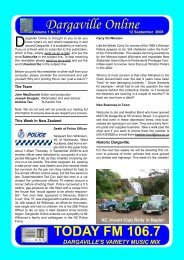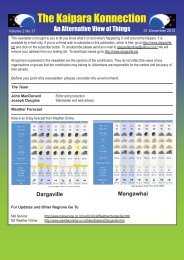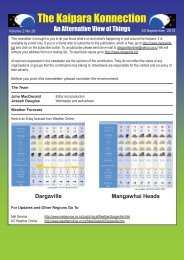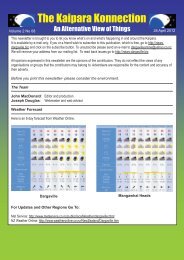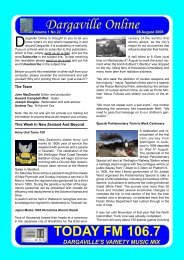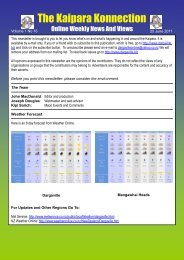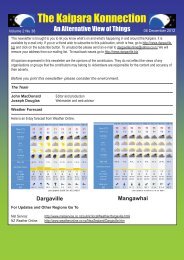9th - Kaipara Konnection Weekly Newsletter - Dargaville.BIZ
9th - Kaipara Konnection Weekly Newsletter - Dargaville.BIZ
9th - Kaipara Konnection Weekly Newsletter - Dargaville.BIZ
Create successful ePaper yourself
Turn your PDF publications into a flip-book with our unique Google optimized e-Paper software.
“If you don’t read the newspaper, you’re uninformed.<br />
If you read the newspaper, you’re mis-informed.” -- Mark Twain<br />
support of a husband, or were inadequately supported by him. It was also available to unmarried mothers and their<br />
children, and to fathers who were the sole parent of one or more children. Women who were living alone and cared for<br />
incapacitated relatives could also claim the DPB.<br />
The traditional image of the nuclear family had begun to change. The idea of the father going out to work while mum<br />
stayed home was not relevant to an increasing number of New Zealanders. Attitudes to marriage in general were<br />
changing and the number of sole parents was rising. These changes had forced a rethink of how sole parents were<br />
supported when relationships ended. (The Act treated de facto relationships as marriages.)<br />
Critics complained that this benefit would lead to an explosion in the number of sole parents. It was argued that it would<br />
be too easy for men to walk away from their responsibilities and place an unfair burden on the taxpayer. The DPB was<br />
also seen as encouraging sole parents to opt out of the workforce.<br />
While men could claim the DPB, the vast majority of those claiming the benefit were women. A new class of New<br />
Zealander was created: the ‘solo mum’. During tougher economic times they came to<br />
symbolise what critics complained was wrong with the welfare state. Those receiving the<br />
DPB were somehow ‘ripping off the system’.<br />
Others argued that the DPB was an important right for women. It gave them and their<br />
children some protection from failed relationships that were potentially harmful. The<br />
DPB’s advocates also argued that as the amount paid was barely enough to cover basic<br />
necessities, it was hardly an incentive for anyone to choose to give up paid work.<br />
Image: Women protesting in 1977<br />
16 November 1840 NZ officially becomes British colony<br />
New Zealand officially became a separate colony of the United Kingdom, severing its link to New South Wales. North,<br />
South and Stewart islands were to be known respectively as the provinces of New Ulster, New Munster and New<br />
Leinster.<br />
William Hobson had been appointed Britain’s consul to New Zealand in 1839. He was instructed to obtain sovereignty<br />
over all or part of New Zealand with the consent of ‘a sufficient number’ of chiefs. New Zealand would then come under<br />
the authority of George Gipps, the governor of New South Wales; Hobson would become Gipps’ lieutenant-governor.<br />
On 21 May 1840 William Hobson proclaimed British sovereignty over all of New Zealand, the North Island on the basis<br />
of cession through the Treaty of Waitangi and the southern islands by ‘right of discovery’. Signatures to the Treaty were<br />
still being sought. Hobson may have wanted to declare the Crown’s authority over the whole country because he had<br />
learned that the New Zealand Company had plans to set up its own administration around Cook Strait.<br />
Shortly before Hobson left Sydney in January 1840, Gipps had issued a proclamation extending the boundaries of<br />
New South Wales to include such territory in New Zealand as might be acquired in sovereignty. The Legislative Council<br />
of New South Wales passed an Act extending to New Zealand the laws of New South Wales on 16 June 1840 and<br />
established customs duties and courts of justice here.<br />
The relationship with New South Wales was intended as a convenience to cover the period during which British<br />
sovereignty over New Zealand was being asserted. Even before Hobson’s dispatch reporting his proclamations had<br />
reached London, his political masters had decided to make New Zealand a separate colony. The ‘Charter for erecting<br />
the Colony of New Zealand’, effective from 16 November 1840, also constituted a nominated Legislative Council. The<br />
provincial divisions were at first of geographical significance only. They were not used as a basis for the government of<br />
the colony, which was centralised in Auckland.<br />
In 1846 a further Royal Charter divided the colony into two provinces and provided each with its own political institutions<br />
Raan Ahaan Thai Aroi Dee - Thai Restaurant<br />
57 Victoria Street <strong>Dargaville</strong>. Phone (09) 439 1081<br />
Dine in - Takeaways - Open 6 Days - Closed Monday



